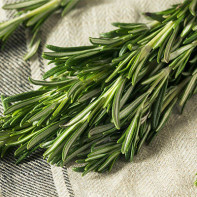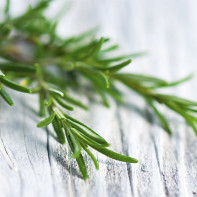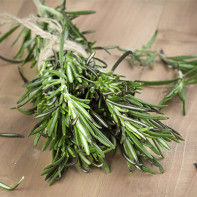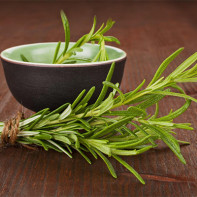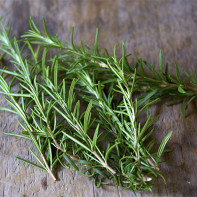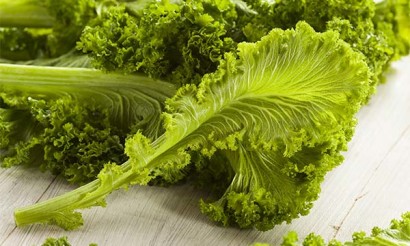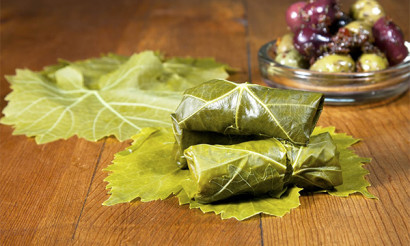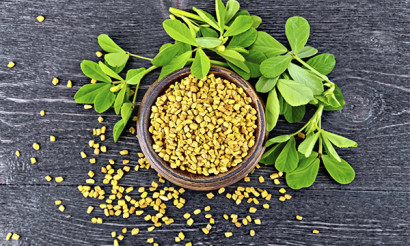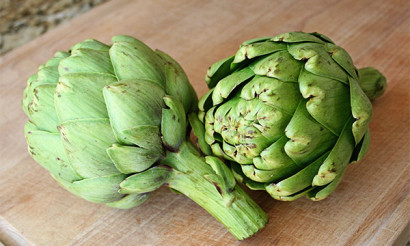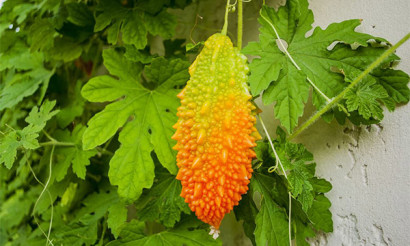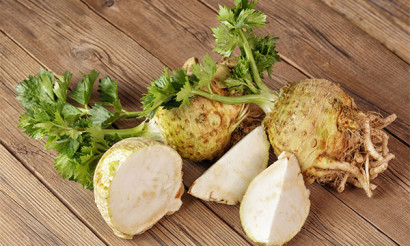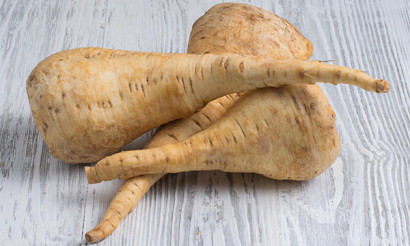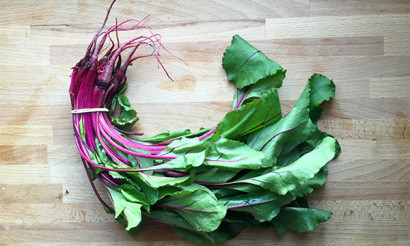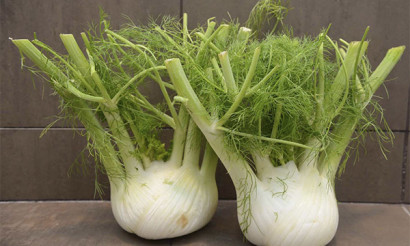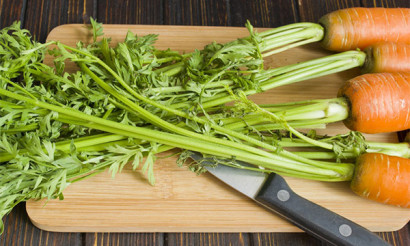Rosemary (spice): useful properties and contraindications
Rosemary, an evergreen shrub from the family of Sponges, has several names. Connoisseurs call it frankincense grass, dyke, wedding flower or sea dew. It first became known to the inhabitants of the Mediterranean, and then spread to the territories of North Africa, as well as Transcaucasia, Crimea and Central Asia. Its well-developed root system, up to 3 meters long, is known to grow on mountain slopes where the climate is dry and rainfall is rare. The underground water that feeds rosemary allows it to be green all year round. The stems are from half a meter to a meter and a half long.
- What is rosemary and what does it look like
- What is the difference between thyme and rosemary
- Composition and calories
- Useful properties of rosemary
- For Women
- For Men
- In Pregnancy
- Breastfeeding
- For children
- When losing weight
- What is rosemary tea good for?
- Rosemary essential oil: properties and uses
- The use of rosemary in traditional medicine
- Decoction
- Aqueous Infusion
- Alcohol tincture
- Inhalation
- Rosemary in cosmetology
- For Face
- For Hair
- Rosemary in Cooking
- Where to season
- What can be substituted?
- Harms and Contraindications
- How to Choose and Store Rosemary
- How to grow rosemary at home
- Interesting facts about rosemary
What is rosemary and what does it look like?
It is a plant with a grayish-brown bark, with 4-sided branches on which there are elongated voluminous leaves. Externally and to the touch, the sides of the leaves are different: one side is glossy, the other - matte and somewhat coarse.
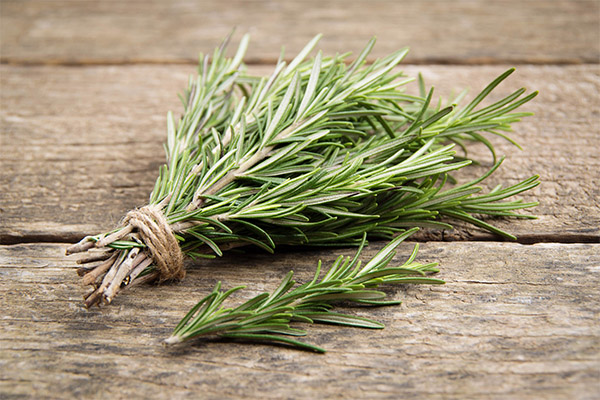
The flowers of the shrub are 5-10 buds on the tops of twigs with small flowers of pale purple or white-blue color. After flowering, about 4 gray-brown nuts appear at the bottom of the flower cup.
Rosemary has a bitter aftertaste and a tart scent, somewhat like basil but more like pine.
What is the difference between thyme and rosemary?
Thyme is a small perennial shrub in the Yarrow family. It was first discovered in North Africa. In the descriptions of ancient Greek philosophers, it is called an incense, which means "incense substance." In Russia, it was called thyme or thyme, as well as Bogorod herb, lemon pout, muhopal, incense, chebarka, verest. This genus is distinguished by its many species found in Greenland and Eurasia.
Unlike rosemary, it is a smaller plant, 15-35 centimeters tall, which flowers not in spring but in summer, in June-August. It also differs in its leaves, which are rounded, occasionally elongated and small with a pubescent underside. The leaves do not exceed one centimeter in size. The flowers of thyme, unlike rosemary, are bright: pink, purple or lilac, with a strong fragrance.
Composition and calories
In Central Europe and the Mediterranean, rosemary is cultivated as an agricultural plant. The plant is known more as a condiment in cooking, where the shoots, flowers and leaves are used.
Composition:
- B9, A, C, E, PP are vitamins that make rosemary good for the body.
- Minerals, namely sodium, potassium, calcium, iron, as well as magnesium, fiber and various essential oils - the chemical composition of rosemary is surprising.
- Myristic, caprylic, as well as oleic, rosemary, palmitic, beneficial ursolic, lauric and linoleic acids are the variety of organic unsaturated acids in this plant.
- Thanks to isoleucine, phytosterols, phytoncides, threonine, carnosol, valine, lysine, rosmanol, tannins, flavonoids, particularly apigenin and luteolin, rosemary can be called a "living pharmacy".
Rosemary contains 5.5 grams of protein, 7.7 grams of lipids and 23 grams of carbohydrates. With such a richness of composition, there are 161 kcal per 100 grams of spice.
Useful properties of rosemary
A medicinal herb, rosemary is now a popular herb on every continent and a flavorful, healthy spice. Over the centuries, the leaves of this evergreen herb have been used to treat illnesses and to make medicinal teas, alcoholic tinctures and inhalation decoctions. The usefulness of rosemary has been proven by many experts.

For women
- Regular use of the spice is beneficial not only to the urogenital system, but also to the important reproductive function of the female body.
- Women's susceptibility to headaches, migraines, neurological symptoms, such as frequent mood swings during the day, stress and depression, can be eliminated by regular use of a simple to prepare decoction of rosemary (read the recipe below in our article).
- The plant provides effective help to women who have problems associated with premenstrual syndrome. Thanks to the reception of herbal tea with rosemary, mint and St. John's wort, hormonal fluctuations and headaches are reduced.
- There is evidence that the spice is able to normalize the menstrual cycle and restore it in the absence of menstruation for a long time.
- In the fight against candidiasis, which often affects women, effective help has a sprinkling decoction.
For men
If there are problems with the activity of the genitourinary system and reproductive function in men, with the regular use of the spice everything comes back to normal.
From time immemorial, rosemary has been used in the treatment of prostatitis, cystitis, orchitis and other male health problems. It also helped in improving potency, actively used by men for the prevention of impotence, the so-called andropause, that is, cope with the signs of natural aging men. Decoction of rosemary, immortelle, as well as dried sage, birch buds, which is consumed 20 minutes before a meal, or antibacterial warm hygienic baths from such decoction have a very beneficial effect on the male body.
Rosemary also increases male libido, as it is an aphrodisiac.
When pregnant.
Natural spice has a beneficial effect on the body of a pregnant woman.
- The dopamine in rosemary helps to reduce stress and improve the mood of the expectant mother.
- Massage with rosemary oil relieves back and lower back pain, reduces swelling in the legs, reduces the signs of nausea.
- To disinfect the air and kill staphylococcus bacilli, yeast fungi and other germs, along with aromatic natural rosemary oil, systematic use of aroma lamps is also useful.
- Episodes of bad moods, fatigue of pregnant women will disappear if you add 5 ml of rosemary oil in the water when taking a bath. Such baths are useful to maintain normal skin and hair.
It is necessary to remember that rosemary can be toxic if used in excessive intake.
When breastfeeding
Rosemary is a natural remedy that has beneficial effects on lactation when breastfeeding. It is also indispensable in cases where insufficient milk is produced.
A woman during the breastfeeding period can use rosemary to prevent migraines, dizziness, insomnia, colds. This will have a beneficial effect on her body.
For children
- Rosemary is useful for children over the age of 4. It will benefit elementary school students who have problems with concentration.
- The microclimate in the apartment, where there is a child, will be better if you use rosemary oil in an aroma lamp as an antiseptic that kills pathogens.
- Rosemary many folk healers used in the treatment of skin diseases in children, to heal wounds and reduce pain. Compressions, ointments, prepared on the basis of this plant, help with neuralgia, all kinds of boils, badly festering wounds.
- Natural essential oil drops of rosemary applied to the temples of a child with acute respiratory infections/flu and headaches will quickly help to improve his condition. Inflammation of the throat is relieved by gargling with rosemary.
- Using the plant as an inhalant for asthma helps in relieving swelling and soothes inflammation in the throat. It is important to remember, however, to ask for a recommendation from a specialist.
- Rosemary stimulates circulation, can slightly raise blood pressure, and the natural essential oil used for rubbing will help in getting rid of the problem of cold hands/feet of a child.
For weight loss.
- Rosemary helps speed up the metabolism, so it is used as a weight loss aid. Green leaves or a pinch of dried herbs used as a spice can promote weight loss.
- The greater effect can be achieved by consuming instead of large doses of rosemary its water infusion a few minutes before meals. Thanks to this method, the body receives a daily dose of the necessary substances for the body.
- Useful for weight loss essential oil of rosemary. Applied to the skin, it increases blood circulation, acting as a light drainage, helps to break down fats. Thanks to this property of the oil body volume decreases, cellulite disappears. The content of carnosolic acid in the oil slows down skin aging.
- Wraps or baths with the addition of essential natural oil help to eliminate skin flabbiness. These procedures are also effective in the fight against cellulite. And massage for weight loss will be more effective if you add one part of rosemary oil to the base oil.
- The essential oil, used in aromatherapy, helps to activate the brain centers responsible for satiety, which helps to reduce feelings of hunger.
How rosemary tea is useful
The taste and aroma of natural rosemary tea is no comparison with store-bought. It is not only pleasant to taste, but also very useful as a preventive measure for some diseases. Such a drink can strengthen the immune system.
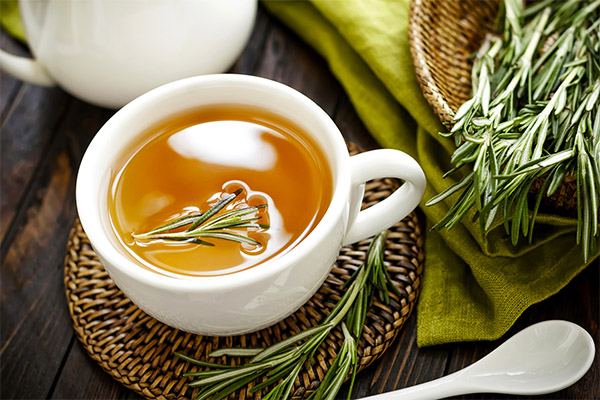
Studies have shown that acids and antioxidants present in the plant prevent the destruction of neurotransmitters. They largely determine the state of mind, memory, consciousness. Tea with rosemary helps to restore memory, does not give rise to dangerous, especially for the elderly, Alzheimer's disease. The drink is useful for the development of concentration.
There are noted other useful properties:
- It is a special tea that helps improve blood circulation, relieves headaches, fights infections and fungi.
- The useful substances and trace elements in its composition make up for the lack of elements in the body.
- In diseases of the gastrointestinal tract, tea with rosemary acts as a preventive drink.
- For those wishing to get rid of extra pounds, the aromatic tea will be an invaluable service, as it speeds up the metabolic processes in the body. The drink helps to restore strength after illness.
- Tea with rosemary is useful in the treatment of skin diseases, including eczema.
- The antiseptic property of the tea is used to cleanse the body of pathogenic microflora, which are staphylococcal, streptococcal, fungal microorganisms. These microbes multiply in the body by feeding on the remains of undigested rotting fried or cooked food.
- The beneficial effects of rosemary tea on the liver, lungs and respiratory system have been proven by scientists studying the effects of phytopreparations on the human body.
- People with back pain, muscle pain, rheumatism, osteoarthritis are easier to tolerate the disease if their diet contains tea with rosemary.
- It is no less remarkable that in the fight against cancer this drink also has a positive effect.
- The beneficial effects of this drink on the skin and hair have been known since ancient times.
So, rosemary tea is not only a very flavorful drink, but also very healthy.
Rosemary essential oil: properties and uses
Of no less importance than rosemary itself is the essential oil extracted from the leaves through steam distillation. The oil is a virtually colorless or slightly yellowish fluid of thick oily consistency, which has a pleasant rich smell. There are no differences in the medicinal properties of rosemary and the product produced from it in the form of essential oil.
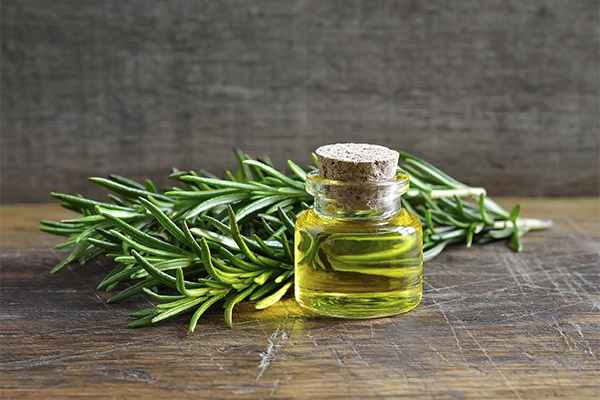
The usefulness of the essential oil of this plant lies in its analgesic, antispasmodic, regenerative and even wound-healing effects on the body:
- This rosemary derivative has properties that help in the treatment of migraines, headaches of various origins, in the spine area and in progressive rheumatism.
- The dissolution of gallstones, improvement of choleretic functions, and normalization of liver function - these are the capabilities of rosemary essential oil.
- This oil can reduce "bad" cholesterol, improve digestion, remove constipation and bloating.
- It can also improve cardiovascular activity, strengthen blood vessels, stabilize blood pressure, help in the treatment of varicose veins - all this is also possible with the use of this therapeutic product.
- If you need to relieve eye strain, restore visual acuity, improve brain activity and memory, relieve mental and intellectual stress, facilitate the process of perception, normalize brain functions of concentration and remembering information, it is just worth using this product.
- Rosemary oil can stimulate and strengthen the human immune system, contribute to the treatment of colds and flu.
- The beneficial effect of this product on the skin and sebaceous glands noted in inflammatory diseases. With its help, dandruff is eliminated, alopecia and hair loss is slowed, fungus of the nails and skin is treated.
Application:
- Both rosemary itself and the essential oil produced from it are beneficial to the female and male body. For the former, it helps to normalize the menstrual cycle and relieve the pain that accompanies it, for the latter, it is useful in the prevention and treatment of problems with impotence and frigidity.
- Its wound-healing and pronounced regenerating action allows the oil to be used to accelerate healing effects on scars, scars left on the skin, deep cracks on the elbows/legs.
- Thanks to its psychoemotional properties, rosemary oil is indispensable in the treatment of neuroses, the so-called chronic fatigue syndrome.
- People worried about their hair, such as hair loss, loss of silkiness or greasy hair, should use a rosemary oil mask. Alopecia, or the sudden appearance of dandruff, however, even the simple care of your locks may also be an important reason to use this product for care. For this purpose it is enough to add 2-3 drops in shampoo or on a comb, preferably wooden, when combing. Twice a week of such treatments will lead to positive results.
- Problems with oily skin, inflammation and pimples are successfully solved with rosemary essential oil. Dermatitis, eczema, furunculosis, skin roughness, pigment spots of any kind will not resist the pressure of this oil.
- Gastrointestinal diseases, colitis, bloating, cholelithiasis, high blood cholesterol, heart and vascular pathologies are also subject to this product. Taking 2-3 drops of the ether dissolved in a teaspoon of vegetable oil twice a day will improve the condition of the body. It is worth remembering that a doctor's recommendation is mandatory.
- The tart, light woody notes in the smell of rosemary essential oil have made it one of the most popular in aromatherapy. The positive effect of its fragrance is used by specialists to improve a person's mental general condition, mood, clarify thoughts, increase concentration, strengthen memory, in particular for amnesia.
- Headache, severe migraine, any nervous tension, apathy, any neurotic periods in life - these problems can be solved if you conduct aromatherapy sessions at home using the natural oil of this plant. Such sessions will help if there is pain in the spine and joints, reduced sexual activity. 3-5 drops in an aroma lamp indoors, 2 drops in aromatic medallions, 8 drops in warm water during the bath will have a positive effect.
The use of rosemary in traditional medicine
The medicinal properties of rosemary have made it an important component in folk medicine. Its leaves, stems and roots are used fresh or made into tinctures, decoctions and teas.
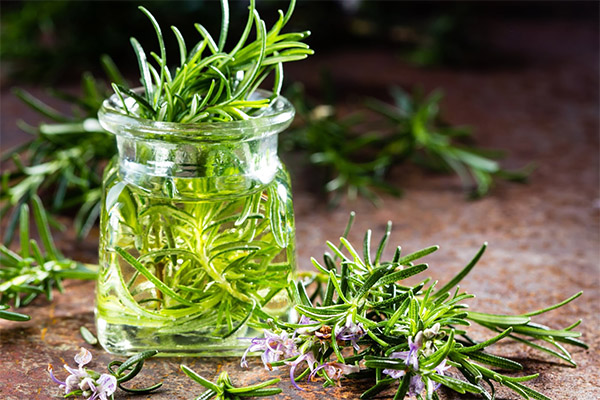
Decoction
Folk medicine advises the use of decoction of rosemary in respiratory diseases. To relieve breathing, it is enough to take a decoction strained during the day at least 3-4 times. To prepare it, use 2 teaspoons of raw materials poured into a glass of boiling water. The drug will be ready after 20 minutes of boiling on low heat.
Aqueous infusion
Rosemary in an aqueous infusion is used for joint pain, in the fight against excess weight as a tonic. Pour an incomplete tablespoon of chopped rosemary leaves into a thermos and steep boiling water and insist for about one hour. The strained preparation is used as directed before eating one teaspoon.
Alcoholic Tincture
Dried or fresh stems and leaves of rosemary are usually infused in alcohol. This method of use is considered in folk medicine the most productive: the components that make up the plant are extracted as much as possible, and their effect is more profound compared to other folk remedies using rosemary. The concentration of the components present in the alcoholic tincture predetermines the way they are used: internally or externally. To prepare the tincture it is necessary to use glass, ceramic or enamel-coated glassware.
- flatulence, nervous disorders, loss of appetite, low blood pressure will cure the remedy prepared from 10 grams of dry and crushed leaves of the plant, pour 100 grams of vodka, and infused for 10 days. Filtered liquid is recommended to take 30 drops dissolved in 20 ml of water, three times a day for half an hour before meals.
- In painful joints will help infusion of 50 grams of fresh rosemary leaves and 250 ml of alcohol 70% strength. After 10 days of storage in the dark place it is possible to rub the joints, use it for compresses and instead of lotion for the treatment of problem skin. It is also possible to take the tincture orally with the same dosage as for flatulence.
- For preventive purposes, a spirit tincture of two tablespoons of rosemary, dry or fresh, poured over a glass of vodka and put in a dark place for 10 days is useful. During these days you should periodically shake the remedy. Stored in the refrigerator, the strained liquid is taken 25 drops three times a day.
Inhalation .
Rosemary helps as an inhalant in the treatment of coughs, asthma, sore throat, pharyngitis, loss of voice, to remove phlegm from the airways. A few sprigs of rosemary added to boiling water will help inhale the vapors first through the nose, then through the mouth for ten minutes and will ease breathing.
Rosemary in folk medicine is considered one of the most effective remedies for the prevention and treatment of various diseases. At the same time, you should take into account the recommendations of specialists.
Rosemary in cosmetology
The rosemary is preferred by cosmetologists for fresh rosemary herbs, essential oils, extracts, infusions and decoctions of dried leaves.
Rosemary and various products with its use can be used not only to improve the condition of the face and hair, but also for the decollete and breast area, so that the skin in these areas has become velvety and elastic.
For the beauty of the nails is very useful baths of infusion of dried or fresh herbs rosemary with one teaspoon of salt. Rub the nails with a napkin after 15-20 minutes.
For the face
- Skin will look fresh if you dab it every day with freshly squeezed rosemary leaf juice. After soaking for half an hour, the juice is washed off with warm water. If you do not have fresh product, you can use an infusion of dried herb, brewed one tablespoon with 50 ml of boiling water. The remedy, which replaces the tonic, should be replaced after two days with a fresh one.
- A mask of a pulp of fresh rosemary herbs mixed with cucumber, oatmeal or the pulp of a fruit such as a banana is also useful. It rinses off with water after a quarter of an hour.
Thanks to rosemary is saturated facial skin with vitamins, its rejuvenation, the prevention of wrinkles, there is an activation of metabolic processes in the epidermis. To avoid redness of the skin, itching, tingling, it is necessary to make a test, as contained in the herbs rosemary esters and camphor can be harmful.
Beautifully groomed eyebrows are the jewel of the face. They will become thick if you nourish them daily with freshly squeezed juice from rosemary leaves or wipe them with a decoction of the dried product.
For Hair
If you apply this spicy herbs, hair loss will stop, dandruff, split ends, dullness will disappear.
- A decoction made from dried or fresh rosemary shoots, infused for a couple of hours, cooled and strained will help with regular rinsing of hair to make it thick and silky.
- Useful for hair will be decoctions, oils, juices, squeezed from the plant, which can be rubbed into the scalp. There is a limitation for rosemary extract - it can harm the roots of the hair.
Now it is clear that rosemary is a useful tool in cosmetology.
Rosemary in cooking
Cooks everywhere use rosemary spice, which has a lemon-sweet aroma and a spicy-bitter taste. Italian, Greek, and French cuisines, being the birthplace of this spice, use it in their many dishes. But chefs in the Middle and Near East also have a special fondness for it.
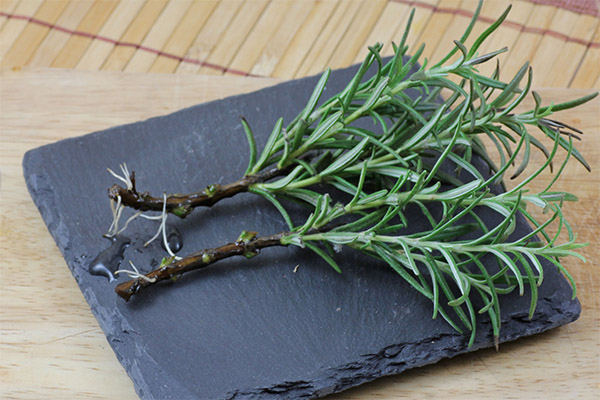
The use of this spice is not limited to any form. It is as good in the form of cut fresh sprigs as it is in the form of dried crushed leaves. Freshly picked twigs are more aromatic and richer in essential oils, which is not the case with the dried product. True, it is more available at any time of the year, which cannot be said about the fresh plant.
In addition to the fact that the spice is used for cooking appetizers, hot dishes, sweets, pickles and even drinks, nutritionists advise to use just a pinch of spice to speed up the metabolism, as a result of which the water-fat balance is restored and the body is purified of toxins.
For a dish to get a special flavor, you need to combine parsley, thyme, garlic, lemon, black pepper, chili pepper and marjoram with rosemary. But rosemary and bay leaf are "not friends" with each other.
Where to add as a condiment
Not all people can appreciate the flavor of this spice at the first time, but those who have tried it more than once, do not change their predilection. Given the other name of rosemary, "sea freshness", there is no doubt that this spice is suitable for fish and meat dishes. The sprigs of rosemary added to the marinade muffle the specific smells of meat, such as poultry or game. Fish will taste better if you add sprigs of the plant during baking.
Long heat treatment of rosemary does not deprive it of its rich flavor. Soup, gravy, boiled and stewed meats will absorb its flavors regardless of the cooking time. Rosemary is a great flavoring agent for cheese, so putting a sprig of rosemary on a pizza or cheese soup will add a special flavor to the dishes. Beans, peas, mushrooms and root vegetables go well with this fragrant herb. Some pasta dishes could also use a sprig of rosemary herbs.
Sprigs of this Mediterranean shrub can be used to flavor vegetable oil. The oil, in which a small sprig of rosemary was dipped, is used to dress salads. This oil is suitable for baked and stewed vegetables.
Important! Rosemary as a preservative is recommended for use in canning and leavening, because it can prevent food from spoiling.
Doses of rosemary use depend on its condition. The rich smell of fresh bush greens suggests the use of no more than one small sprig. In dried spice, the smell is not very pronounced, but, as culinary experts advise, one teaspoon of spice for meat dishes and marinades will be quite enough.
Whatever a person's attitude towards this spice, it is necessary to observe the norms of its use in the preparation of various dishes. This spice, suitable for meat and vegetable dishes, mushrooms, sauces, soups, cheese snacks and pizza, should be added at the end of cooking, otherwise its bitterness will pass into the food.
What can be substituted for
Sometimes rosemary should be replaced with another spice because of its absence or because of an allergic reaction to it.
- Thyme is the first substitute for rosemary, not only because of its resemblance, but also because of its more delicate fragrance. It would be a good substitute for soups, stews, and cold dishes.
- Estragon instead of rosemary is used only in dried form in meat, fish dishes, also egg and poultry dishes. Estragon is also often used to flavor vinegar.
- Chaber is a spicy herb, more typical of Bulgarian cuisine. Pork and poultry dishes will not be worse if you use chaber instead of rosemary.
- Sage is similar to rosemary in its equally intense flavor. There is not much difference in replacing rosemary with sage for poultry and some seafood and meat dishes. Cooks advise mixing sage with butter or cheese to improve the flavor of some dishes.
- The aroma of marjoram is similar to that of oregano and thyme, so replacing rosemary in stews, sauces, soups, and salads is quite appropriate. By the way, unlike rosemary, it is not the plant itself that is used in cooking, but the seeds. A teaspoon of these seeds will enliven the food, give a twist to salads, fish dishes.
- The most common substitute for rosemary in cooking is the bay leaf. Its flavor is lighter, so it has a wider range of applications than its "brother".
- Oregano and basil are good substitutes for rosemary, but dried or fresh they are readily available.
The lack of spice is quite made up for by other spices with similar properties and flavors.
Harms and Contraindications
The excessive use of any product, even the most useful, is fraught with complications.
- Large doses of the spice can cause allergies to the product.
- An overdose can cause vomiting, intestinal cramps, coma, and even fluid in the lungs.
- Excessive use of the spice can lead not only to a reduction in the number of sperm cells. Their density and motility decreases, which can adversely affect fertility, meaning a man can lose the ability to reproduce viable offspring.
- If a person uses rosemary purposelessly, the consequence of such use of the spicy plant can be scalp itching, dermatitis or redness of the skin.
- The plant and products made from it, in large quantities, are contraindicated to women during pregnancy and those who are going to become pregnant.
- Rosemary's ability to affect blood glucose levels makes it dangerous in large doses for diabetics and those who have high sugar levels.
Rosemary requires careful attention and adherence to the norms of its use as a spice in food, as well as a cosmetic and therapeutic agent.
How to choose and store rosemary
The place to buy rosemary depends on its species. Thus, fresh rosemary can be found at markets in the grocery sections, and the spice from the dried plant is available in almost every supermarket.
For self-cultivation of the product choose the tender ends of the twigs and leaves. They are torn off gradually in the course of growth. The best time to harvest them is in late summer and early fall.
Rosemary can also be purchased in essential oil capsules.
Storing fresh rosemary does not cause any problems, because its properties are preserved for a long time, even in the refrigerator.
Dried plant is recommended to pour it into an airtight container and place it in a cool and dark place. Proper storage guarantees the preservation of its properties for at least 4 years.
Frozen branches and leaves of the plant do not lose their quality and retain their characteristic flavor.
How to grow rosemary at home
To grow rosemary at home, you can use seedlings from places where they are specially sold: stores and nurseries. You can sow seeds or choose to plant a cuttings of a growing shrub.
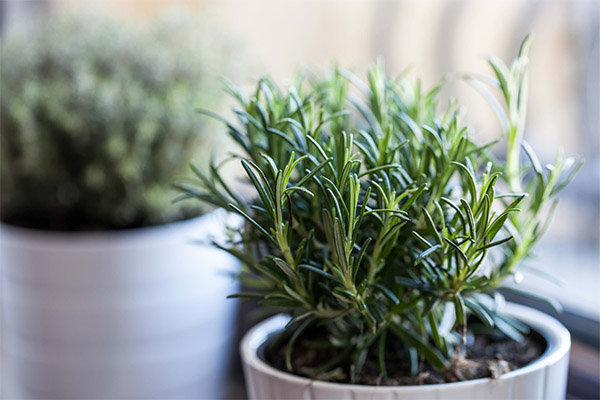
If the decision is made to seed cultivation, the most successful time for their sowing is the beginning of spring. For at least three weeks, containers with seeds, covered with glass or film, should be in a refrigerator or a room with a temperature no higher than 7 degrees. If the seeds do not germinate, you should re-sow them. Germinated seeds can be placed in a room with a temperature not exceeding 12 degrees, watering moderately, without overwatering.
The cuttings method of growing this plant is more common. A young shoot cut from an old rosemary shrub, up to 10 cm in size, is freed from the lower leaves and held for a few seconds in a root-strengthening agent. For the formation of young roots, the cuttings are placed in a container of dark-colored water. After the appearance of roots, the sprig is planted in a flower pot and placed in a sunny and warm place.
To get a good bush, it is necessary to observe the light and temperature regime: for summer - a southern window, for winter - a cool window sill with 15 degrees above zero. To preserve the leaves of rosemary during the cold season, it is important to use artificial light. Summer watering of the plant should be moderate, and winter watering should be sparing and only when the soil is dry. Seasonal feedings will be useful for the plant.
"Homemade" rosemary will not only become useful in all respects spicy plant, but also a decoration of the house.
Interesting facts about rosemary
- This plant is considered an old resident of planet Earth.
- It was endowed with magical properties. Even ancient people kept a sprig of rosemary in the house, believing that it contributed to a happy, prosperous and healthy life. They believed it bestowed eternal youth upon those who used it for medicinal and cosmetic purposes.
- The wisdom of rosemary was also used to ward off evil spirits, and to burn homes to bring good fortune and protection from harm.
- It was also used as a talisman against bad dreams and bad luck. Honeymooners were given a branch of the plant as a symbol of a happy and prosperous family life.
- The ancient Greeks considered the plant a symbol of intelligence and memory. Students of those years adorned their heads with a wreath of rosemary to successfully pass an exam and enhance their mental abilities.
Rosemary is a spicy shrub, an alien from the Mediterranean, which has gained popularity all over the world because of its versatile useful properties.
«Important: All information on this site is provided for informational purposes only. for informational purposes only. Please consult with your health care professional before using any of the recommendations. specialist before using any of the recommendations. Neither the editors nor the authors shall be liable for any possible harm caused by materials."

